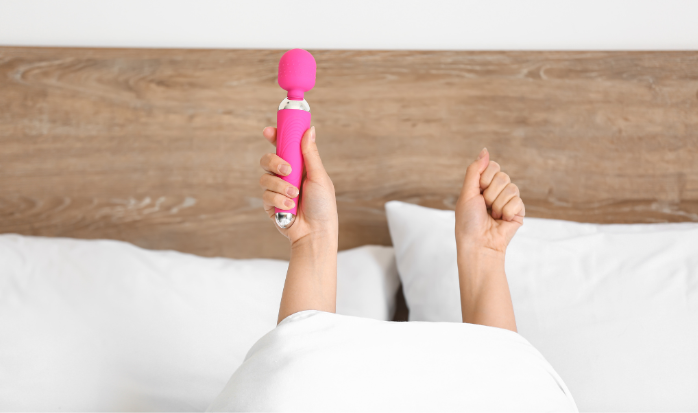Orgasms, the peak of sexual pleasure, can seem like a mystery. They blend intense sensations and pleasure in a way that’s unique to each person. But they’re not always easy to achieve. If you’ve ever wondered how to reach the “Big O,” you’re definitely not alone!
In this article, we’ll break down the science of orgasms and explore the different ways they can happen. We’ll look at the differences between orgasms for people with penises vs. vaginas, and even dive into the wild world of multiple orgasms. You might be surprised to learn there’s more than one way to get there, and it’s not all about finishing!
So whether you’re curious about your own body, wondering how orgasms are good for you, looking to spice things up in the bedroom, or just want to learn something new, keep reading.
Table of Contents
Key Takeaways:
– Orgasms are the height of sexual pleasure, marked by intense sensations that vary from person to person. They’re not just about sex – you can have ’em solo too!
– Women usually have longer orgasms (20-35 seconds) compared to men (under 15 seconds). Some lucky women can have multiple orgasms in a row!
– To boost your orgasm potential, carve out some “me time,” give yourself permission to feel good, and get to know your body’s pleasure spots.
– Orgasms come in different flavors: vaginal, clitoral, nipple, and anal. Each one feels a bit different.
– Achieving orgasm takes practice, experimentation, and maybe some lifestyle changes. A healthy diet, exercise, sleep, and lube can all help.
– Challenges like sexual dysfunction, anxiety, or medical conditions can make orgasms tricky. Don’t be afraid to talk to a doc or sex therapist if you need some guidance.
Understanding Orgasms
To understand what are female orgasms behind the scenes – they’re a complex chain reaction in your body. When you’re getting frisky, your brain, nerves, and various body parts are all working together to build up to that big release. Cool fact: your brain’s response pattern actually changes depending on which body part is being stimulated. So an orgasm from vaginal touch feels different than one from clitoral touch, for example.
What do orgasms feel like? They generally feel different for people with women vs. men. Ladies tend to have longer orgasmic contractions (20-35 seconds on average) compared to men (usually less than 15 seconds). Some women can even have multiple orgasms in a single session – we’re talking anywhere from 2 to 5, or sometimes even a dozen or more!
For more on the big-O during sex, check how to have orgasms during sex
Women also have a few different routes to orgasm. There’s the clitoral orgasm (from stimulating the clitoris), vaginal orgasm (from stimulating inside the vagina), and even orgasms from touching non-genital areas like the breasts. It’s a choose-your-own-adventure situation down there.
Preparing for Pleasure

Before you dive into orgasm territory, it’s important to set the stage for success. Think of it like planning a special date with yourself!
First, block off some quality alone time. Orgasms don’t like to be rushed, so give yourself a generous window to explore. Find a private spot where you feel totally comfortable letting loose.
Next, give yourself permission to feel good. Orgasms happen best when your mind is on board, so let go of any guilt, shame, or judgmental thoughts. Remind yourself that you deserve pleasure!
Finally, get acquainted with your own body. Take a tour of your own erogenous zones:
– The vulva: the external area including the labia and clitoris. Lots of pleasure potential here!
– The clitoris: the pleasure powerhouse with thousands of sensitive nerve endings.
– The G-spot: a sensitive area on the front vaginal wall that some people find pleasurable.
– The A-spot: a lesser-known but highly sensitive spot deep inside the vagina.
– The pelvic floor muscles: they contract during orgasm, so exercising them can boost pleasure.
– The anus: yep, the back door is fair game too! Lots of nerves there.
Don’t forget to set the mood with any extras that help you feel sexy and relaxed – think scented candles, music, or a steamy fantasy. There’s no wrong way to do it. The key is getting comfy and curious!
Struggling with low libido? You’re not alone. Our comprehensive libido quiz is designed to help you identify underlying health issues and emotional factors affecting your desire. Take the Libido Quiz today and take control of your sexual wellness!
Exploring Different Types of Orgasms
Now that you’re primed and ready, let’s talk about the different flavors of orgasm on the menu.
Vaginal Orgasms
Vaginal orgasms can feel a bit like unicorns – magical, but hard to track down. Only about 20% of people with vaginas consistently orgasm from vaginal stimulation alone.
The recipe for success? Lots of arousal, trying different positions and techniques, and a generous dose of lube. A relaxed mind is key too – anxiety is the arch-nemesis of orgasms.
Clitoral Orgasms
Clitoral orgasms are like the “standard” orgasm – they happen from stimulating the clitoris. As you get aroused, the clitoris gets engorged, leading to a release of tension at climax. Clitoral orgasms are often described as more intense and localized compared to vaginal ones. The clitoris usually gets super sensitive afterward, so give it a rest before round two.
Nipple Orgasms
Surprise – orgasms aren’t just for genitals! Some women can orgasm from nipple and breast stimulation alone. Experiment with different types of touch and pressure to wake up the sensitive nerve endings in your nipples.
Anal Orgasms
Despite some outdated taboos, the anus is a legit pleasure zone. It’s packed with sensitive nerve endings that can lead to seriously intense orgasms. The key is to EXTREMELY start slow, use LOTS of lube (silicone lubes last longer), and communicate with your partner about what feels good. Anal play isn’t for everyone, but don’t knock it til you’ve tried it!
The main takeaway? Orgasms can come from all sorts of stimulation. Get creative and experiment to find out what rocks your world. Our team even created a really cool tool, the Orgasmic Perception Questionnaire (OPQ) to determine how you perceive orgasms – check it out, it’s probably not what you think it is!
How to Have Better Orgasms
Like any skill, orgasms get better with repetition including jade egg practice. Don’t get discouraged if it’s not always fireworks – every body is different. Here are some tips to help you crack the orgasm code:
Mix It Up
If you’re in a pleasure rut, try mixing up your regular routine. Experiment with new positions, bring toys into the mix, or play with the pace. Slowing down and letting arousal build gradually can make for a more explosive finish. (or if you really want to explore the edges try female orgasm denial – it’s not for the faint of heart!)
Get Your Head in the Game
Getting out of your head and into your body is key for orgasmic bliss. Focus on the sensations you’re feeling rather than stressing about the end game. Let your imagination run wild with sexy fantasies, or try some mindful breathing exercises to stay in the moment.
Treat Yourself Right
Healthy lifestyle habits can work wonders for your orgasm potential. Eat well, get regular exercise, and prioritize sleep – your sex life will thank you. Some folks also swear by certain supplements for an extra boost (always check with a doc first though).
Use the Right Tools
If you’ve tried all the tips and still feel stuck, consider investing in a quality vibrator or other sex toys. Look for ones with variable speeds and intensity settings so you can gradually turn up the heat.
Lube, Lube, Lube
Slippery = sexy. Using lube can help increase sensation, decrease friction, and make everything feel more pleasurable. Don’t be shy about reapplying as needed, especially during marathon sessions.
Overcoming Common Challenges
For some people, orgasms don’t come easily (pun intended). Let’s troubleshoot some common roadblocks.
Orgasm MIA
If you’ve ever wondered, “Was that an orgasm or did I just sneeze?” you’re not alone. About 30-40% of people with vaginas experience occasional or chronic difficulty reaching orgasm. This is called anorgasmia (the technical term for “I couldn’t get there”).
If you consistently can’t orgasm and it’s bothering you, check out our Masterclass
Sometimes it’s as simple as switching things around or getting more clitoral stimulation during sex.
Fear of Flying Solo
Some folks feel guilt or shame around masturbation and self-pleasure (thanks, society). But solo sex is a great way to learn about your body and what kinda touch makes you tick. Think of it like a sexy research project. Only you know what really takes you over the edge.
Performance Anxiety
Worrying about taking “too long” can pump the brakes on your pleasure. Remember, orgasm is not the ONLY point of sex – it’s about the whole journey, not just the destination. Encourage your partner to relax and focus on the full buffet of sensations instead of racing to a quick finish.
Mind the Gap
Mismatched libidos and differing orgasm ease are common in relationships. If your partner doesn’t struggle to orgasm, they might need some guidance on how to help you get there too. Don’t be afraid to show and tell! Most partners genuinely want to please you.
If you’re really struggling to close the orgasm gap, consider seeing a couples counselor or sex therapist together. They can help you communicate and troubleshoot.
Conclusion
Orgasms are a natural part of sexual pleasure, but there’s no universal instruction manual. Every body (and brain!) is beautifully unique. The path to orgasmic bliss is all about exploring, experimenting, and learning what works for YOU – both solo and partnered.
If you’re dealing with orgasm difficulties, know that you’re not broken and you’re definitely not alone. Be patient with yourself and don’t hesitate to call in back-up from a professional if needed. With a little effort and a lot of self-love, a more satisfying sex life is 100% within reach.
So go forth and orgasm! And remember – as long as you’re having fun, you’re doing it right.
References:
Towne, A. (2019). Clitoral stimulation during penile-vaginal intercourse: A phenomenological study exploring sexual experiences in support of female orgasm. The Canadian Journal of Human Sexuality, 28, 68 – 80. https://doi.org/10.3138/CJHS.2018-0022.
Shaeer, O., Skakke, D., Giraldi, A., Shaeer, E., & Shaeer, K. (2020). Female Orgasm and Overall Sexual Function and Habits: A Descriptive Study of a Cohort of U.S. Women.. The journal of sexual medicine. https://doi.org/10.1016/j.jsxm.2020.01.029.

